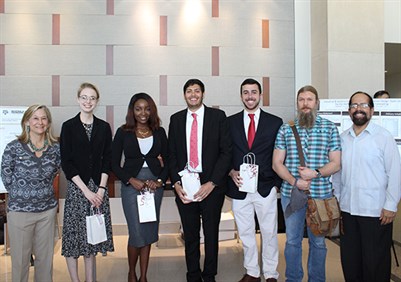Every semester, seniors in the Department of Industrial and Systems Engineering at Texas A&M University enroll in the Capstone Senior Design course. The course’s main objective is to provide students with experience in working on a real-life problem using the general and engineering skills they have gained during their undergraduate education.

At the end of the semester, each team presents its project and poster to other students, faculty members and sponsors. The department presents awards for outstanding work. The first-place team for the spring 2016 semester was comprised of Oluteniola Adeyemi, Hani Arafat, Nathan Sorkin and Sarah Wilson, and was sponsored by the University Writing Center.
“Their services are in very high demand by students,” Arafat said. “Those trying to make an appointment with the Writing Center often found that they had to wait upwards of a week before they could get in.”
The Writing Center’s mission is to help students practice the habits of mature composers of written and oral communication and to provide resources for faculty and teaching assistants for integrating best writing and oral communication pedagogy into courses across the disciplines and in the core curriculum.
After meeting with Dr. Candace Hastings, director of the University Writing Center, and Thadeus Bowerman, a writing consultant at the center, the team realized the need for reduced wait times to better accommodate students seeking help.
“This semester, the University Writing Center started offering half-hour appointments on a trial basis to make more appointments available because at multiple points during the semester students cannot book an appointment for up to two weeks,” Bowerman said. “We met with the industrial engineering team to discuss working the half-hour appointment into our regular schedule on a permanent basis.”
The students spent the rest of the semester designing the best plan for the center and the students served by the center.
“Our goal for this project was to try to reduce these long wait times and increase the number of students that the writing center serves each day by integrating short 30-minute appointments in addition to the longer 60-minute appointments currently offered,” Arafat said. “Our key performance indicators were the number of students the writing center serves, and the percentage of time a tutor spends face-to-face with a student.”
The team developed a proposal that was accepted by Bowerman and Hastings, then began working to solve the issue identified by the client.
“We started our project by building a simulation model, and later randomly generated test schedules using visual basic for applications (VBA) programming software,” Adeyemi said. “We later found the optimal schedule based on the total number of students served per day for each tutor.”
The team ran the simulation over and over to achieve the best results.
“Essentially, the process was as follows: When the simulation was run, clients would arrive at the start of their scheduled appointment, spend time with the tutor according to a random distribution dictated by whether they were a short or long appointment,” Wilson said. “They would then exit the system after a maximum of either 25 or 45 minutes, leaving the tutor with some un-utilized time before the next scheduled arrival.”

After testing 130 random schedules, the team ranked them based on the amount of students served per tutor per day and the percentage of a tutor’s time spent face-to-face with a client.
“This new schedule allows for a 30 percent increase in the number of one-on-one consultations available each day,” Wilson said.
Students seeking help from the writing center will be able to schedule a 30-minute appointment, as well as the 60-minute appointments.
“This gives students more flexibility when booking an appointment that doesn’t conflict with their class schedules,” Arafat said.
Bowerman and Hastings are already implementing the new schedule, allowing consultants more options when deciding the beginning and end times of their shifts.
“The industrial and systems engineering team found practical ways to implement our new appointment times, and they calculated different models that factored not only increasing the number of appointments we can offer, but also factored in a statistical analysis of the most optimum schedule to mitigate tutor burnout,” Bowerman said.
The team members agreed this experience was beneficial to their future careers while improving other students’ experience with the writing center.
“I truly enjoyed working with the writing center,” Wilson said. “I was impressed by the work they do to help the students of Texas A&M, and I am honored that we were able to help them serve even more students.”
The team’s schedule will be fully implemented by August 2016.